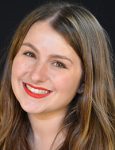
In May, the measles outbreak became the worst in 30 years, as communities across the country continue to battle the pathogen, which has sickened 1,077 people as of June 20, according to the Centers for Disease Control and Prevention.
New York has been one of the hardest hit states in the country, with more than 500 cases, in part because Brooklyn, a borough in New York City, and Rockland County, are homes of large and close-knit Orthodox Jewish communities. Many parents in these communities have decided not to vaccinate their children because of concerns about the health implications of vaccines.
 Politico reporter Amanda Eisenberg has been covering the story for her publication and has been reporting on the story not only as a breaking news topic, but as a way to cover politics, hospital policy, economics and social determinants.
Politico reporter Amanda Eisenberg has been covering the story for her publication and has been reporting on the story not only as a breaking news topic, but as a way to cover politics, hospital policy, economics and social determinants.
To “distinguish your reporting,” says Eisenberg. “Find a way to take this to a new angle.”
For example, Eisenberg took a deep dive into the database created by the state health department on school vaccination rates. Eisenberg is familiar with using database computing tools, so she was able to comb through school records across the state to determine if there were schools other than those in Rockland County and Brooklyn that have a high number of religious exemptions from vaccination.
Because measles becomes highly contagious if less than 95% of a population is vaccinated, she was able to filter by school year, and then by religious exemption rate to determine which schools might be vulnerable to an outbreak. She found potentially 400 schools in the state with low enough vaccination rates to pose risks to students. The schools were not just in Orthodox Jewish communities. The list included Montessori schools, Muslim schools and other religious schools.
Eisenberg also wrote about how hospitals in the state were boosting disease control measures to prevent an outbreak within their walls, in case anyone with measles entered the building. She also worked on a piece about the high cost to the city of trying to control the disease, and she looked at how vulnerable populations might be affected by the outbreak.
For Politico, among the biggest challenges was working through concerns that writing so many stories about the Orthodox Jewish community might expose the publication to charges of anti-Semitism. To combat that concern, Eisenberg said she always made sure to explain what measles is, how it spreads and how to prevent it, as well as underscore that vaccines don’t cause autism.
“A big conversation we had in the newsroom and saw play out in the media is how to make sure coverage isn’t anti-Semitic,” Eisenberg said. “We want to be culturally sensitive in promoting science.”
To learn more behind the scenes of how Eisenberg covered the measles outbreak, her approach and suggested resources, read our latest “How I Did It” piece here.









